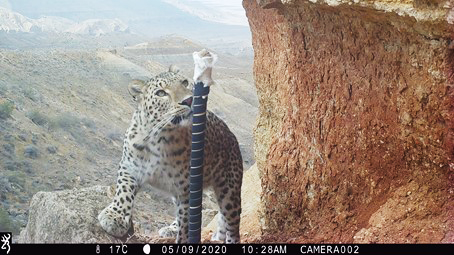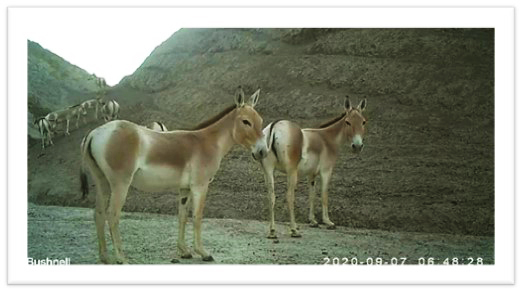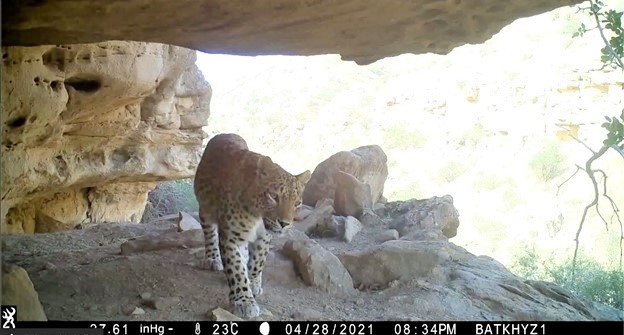The Center is increasingly engaging with partners across Central Asia to build capacity, promote research, and implement connectivity conservation efforts in the countries of Kazakhstan, Kyrgyzstan, Tajikistan, Turkmenistan, and Uzbekistan. We are proud to be part of growing collaboration across this globally important biodiversity hotspot that has, among other progress, yielded important scientific evidence about the presence of an endangered and charismatic species—the Persian leopard (Panthera pardus tulliana)—in Turkmenistan and Kazakhstan.
The Central Asian Ecological Connectivity Initiative is led by Tatjana Rosen, Conservation Science Fellow at the Center, who has been working across the region since 2011. The Initiative was created in 2019 to enhance knowledge of wildlife ecology, help decrease human-wildlife conflict and illegal wildlife killing, expand transboundary partnerships, and inform national, regional, and international policies.

Local conservationists in these two large, sparsely populated, and biodiversity-rich countries have been working for years to better understand species’ movement and ecology, while providing high-quality science, improving management capacity, and strengthening relationships with local communities. As part of the activities under the Central Asian Desert Initiative (CADI), scientific staff at the Ustyurt State Nature Reserve were successful recording the only currently known Persian leopard in Kazakhstan. Called “Tau Sheri” (Spirit of the Mountains), this male likely entered from neighboring Turkmenistan. He was first “camera trapped” at the end of November 2020 and last recorded in the winter of 2021. During the summer he likely moves to areas with greater access to water. Additionally, consistent camera trap recordings were made throughout the summer of Caracal and Asiatic wild cat, as well as goitered gazelle and Urial sheep, which are important prey for leopards.

Additionally, working with colleagues from the Association for the Conservation of Biodiversity of Kazakhstan (ACBK) and supported by the CADI project, the team prepared a scientific justification for protecting the Persian leopard. It was recently approved in March 2021 by the Kazakh government, listing the species in its official Red Book of Endangered Species that are subject to special protection. Prior to that, Persian leopards could be killed with impunity.

In the Big Balkan Mountains—in the northwest of Turkmenistan—camera traps have recorded nine distinct Persian leopards, including the latest, which is a female with two cubs. In the process, a team of partners also camera trapped a Pallas’s cat for the first time, which not only had never been photographed in the area but was last seen in 1940! South of the Big Balkan range, in the Western Kopet Dag Mountains, camera traps also captured a small population of Kulan (Wild Ass). Kulan in Turkmenistan are only found in two very small populations that are facing competition for resources due to domesticated grazing, as well as barriers to access water sources, such as a fence on the country’s southeast border.

Although 2020 started with great plans and ambitions, government measures due to the COVID-19 pandemic closed borders and kept people home across the region. Yet, armed with patience and some creativity, the year was filled with many discoveries and progress that included small but important steps towards securing the conservation of Persian leopards. The Center and partners in Central Asia look with hope toward the remainder of 2021 and continuing to discover, inspire, and advance conservation action in the region. This includes a process to adopt recommendations and a regional strategy for conservation of the Persian leopard within the framework of the Convention on the Conservation of Migratory Species (CMS), strengthen wildlife monitoring, and increase cooperation across landscapes and countries.



